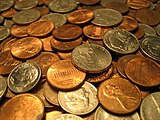In electronic financial markets, algorithmic trading or automated trading, also known as algo trading, black-box trading or robo trading, is the use of computer programs for entering trading orders with the computer algorithm deciding on aspects of the order such as the timing, price, or quantity of the order, or in many cases initiating the order without human intervention. Algorithmic Trading is widely used by pension funds, mutual funds, and other buy side (investor driven) institutional traders, to divide large trades into several smaller trades in order to manage market impact, and risk.[1][2] Sell side traders, such as market makers and some hedge funds, provide liquidity to the market, generating and executing orders automatically. A special class of algorithmic trading is "high-frequency trading" (HFT), in which computers make elaborate decisions to initiate orders based on information that is received electronically, before human traders are capable of processing the information they observe.
Algorithmic trading may be used in any investment strategy, including market making, inter-market spreading, arbitrage, or pure speculation (including trend following). The investment decision and implementation may be augmented at any stage with algorithmic support or may operate completely automatically ("on auto-pilot").
A third of all EU and US stock trades in 2006 were driven by automatic programs, or algorithms, according to Boston-based financial services industry research and consulting firm Aite Group.[3] As of 2009, high frequency trading firms account for 73% of all US equity trading volume.[4]
In 2006 at the London Stock Exchange, over 40% of all orders were entered by algo traders, with 60% predicted for 2007. American markets and european markets generally have a higher proportion of algo trades than other markets, and estimates for 2008 range as high as an 80% proportion in some markets. Foreign exchange markets also have active algo trading (about 25% of orders in 2006).[5] Futures and options markets are considered to be fairly easily integrated into algorithmic trading,[6] with about 20% of options volume expected to be computer generated by 2010.[7] Bond markets are moving toward more access to algorithmic traders.[8]
One of the main issues regarding high frequency trading is the difficulty in determining just how profitable it is. A report released in August 2009 by the TABB Group, a financial services industry research firm, estimated that the 300 securities firms and hedge funds that specialize in this type of trading took in roughly $21 billion in profits in 2008.[9]
Algorithmic and high frequency trading have been the subject of much public debate since the U.S. Securities and Exchange Commission and the Commodity Futures Trading Commission implicated them in the May 6, 2010 Flash Crash,[10][11][12][13][14][15][16][17] when the Dow Jones Industrial Average suffered its largest intraday point loss ever to that date, though prices quickly recovered.
Contents[hide] |
- Outline of finance
- Alternative Trading Systems
- Artificial Intelligence
- Complex Event Processing
- Dark pools of liquidity
- Electronic Communication Network
- Electronic trading
- Electronic trading platform
- Implementation shortfall
- Investment strategy
- Quantitative trading
- Execution Management System
- Flash Crash
- High-frequency trading

댓글 없음:
댓글 쓰기